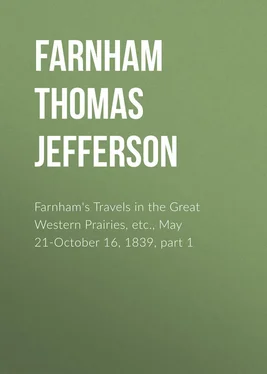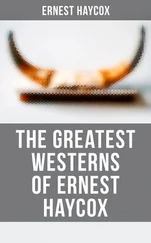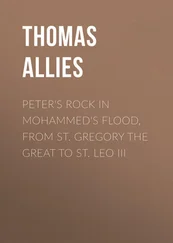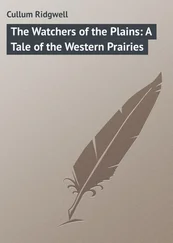Thomas Farnham - Farnham's Travels in the Great Western Prairies, etc., May 21-October 16, 1839, part 1
Здесь есть возможность читать онлайн «Thomas Farnham - Farnham's Travels in the Great Western Prairies, etc., May 21-October 16, 1839, part 1» — ознакомительный отрывок электронной книги совершенно бесплатно, а после прочтения отрывка купить полную версию. В некоторых случаях можно слушать аудио, скачать через торрент в формате fb2 и присутствует краткое содержание. Издательство: Иностранный паблик, Жанр: foreign_antique, foreign_prose, Путешествия и география, на английском языке. Описание произведения, (предисловие) а так же отзывы посетителей доступны на портале библиотеки ЛибКат.
- Название:Farnham's Travels in the Great Western Prairies, etc., May 21-October 16, 1839, part 1
- Автор:
- Издательство:Иностранный паблик
- Жанр:
- Год:неизвестен
- ISBN:нет данных
- Рейтинг книги:3 / 5. Голосов: 1
-
Избранное:Добавить в избранное
- Отзывы:
-
Ваша оценка:
- 60
- 1
- 2
- 3
- 4
- 5
Farnham's Travels in the Great Western Prairies, etc., May 21-October 16, 1839, part 1: краткое содержание, описание и аннотация
Предлагаем к чтению аннотацию, описание, краткое содержание или предисловие (зависит от того, что написал сам автор книги «Farnham's Travels in the Great Western Prairies, etc., May 21-October 16, 1839, part 1»). Если вы не нашли необходимую информацию о книге — напишите в комментариях, мы постараемся отыскать её.
Farnham's Travels in the Great Western Prairies, etc., May 21-October 16, 1839, part 1 — читать онлайн ознакомительный отрывок
Ниже представлен текст книги, разбитый по страницам. Система сохранения места последней прочитанной страницы, позволяет с удобством читать онлайн бесплатно книгу «Farnham's Travels in the Great Western Prairies, etc., May 21-October 16, 1839, part 1», без необходимости каждый раз заново искать на чём Вы остановились. Поставьте закладку, и сможете в любой момент перейти на страницу, на которой закончили чтение.
Интервал:
Закладка:
The morning breezes were bland, and a thousand young flowers gemmed the grassy plains. It seemed as if the tints of a brighter sky and the increasing beauty of the earth were lifting the clouds from the future, and shedding vigour upon our hopes. But this illusion lasted but a moment. Three of my valuable men had determined to accompany the waggoners to the States; and as they filed off and bade adieu to the enterprise in which they had embarked, and blighted many cheering expectations of social intercourse along our weary wayfaring to Oregon, an expression of deep discouragement shaded every face. This was of short duration. The determination to penetrate the valleys of Oregon soon swept away every feeling of depression, and two hunters being sent forward to replenish our larder, we travelled happily onward.
The Osage River at this place is one hundred yards wide, with about two-and-a-half feet of water. Its banks are clothed with timber of cotton-wood, ash and hickory. We crossed it at eight o'clock in the morning, passed through the groves which border it, and continued to follow the Santa Fé trail. The portion of country over which it ran was undulating and truly beautiful; the soil rich, very deep, and intersected by three small streams, which appeared from their courses to be tributaries of the Osage.
At nightfall, we found ourselves upon a height overlooking a beautiful grove. This we supposed to be Council Grove. On the swell of the hill were the remains of an old Kauzaus' encampment; a beautiful clear spring gushed out from the rock below. The whole was so inviting to us, weary and hungry as we were, that we determined to make our bed there for the night. Accordingly, we fired signalguns for the hunters, pitched our tents, broke up the boughs which had been used by the Indians in building their wigwams, for fuel, and proceeded to cook our supper. This encampment had been made by the Kauzaus six years ago, when on their way south to their annual buffalo-hunt. A semi-circular piece of ground was enclosed by the outer lodges. The area was filled with wigwams, built in straight lines, running from the diameter to the circumference. They were constructed in the following manner. Boughs of about two inches in diameter were inserted by their butts into the ground, and withed together at the top in an arched form; over these were spread blankets, skins of the buffalo, etc. Fires were built in front of each: the grass beneath, covered with skins, made a delightful couch, and the Indian's home was complete. Several yards from the outer semi-circular row of lodges and parallel to it, we found large stakes driven firmly into the earth, for the purpose of securing their horses during the night. We appropriated to ourselves, without hesitation, whatever we found here of earth, wood or water, which could be useful to us, and were soon very comfortable. About nine o'clock, our signalguns were answered by the return of our hunters. They had scoured the country all day in quest of game, but found none. Our hopes were somewhat depressed by this result. We had but one hundred pounds of flour and one side of bacon left; and the buffalo, by the best estimates we could make, were still three hundred miles distant; the country between us and these animals, too, being constantly scoured by Indian hunters, afforded us but little prospect of obtaining other game. However, we did not dwell very minutely upon the evils that might await us, but having put ourselves upon short allowance, and looked at our horses as the means of preventing starvation, we sought rest for the fatigues of the next day's march.
In the morning we moved down the hill. Our way lay directly through the little grove already referred to; and, however we might have admired its freshness and beauty, we were deterred from entering into the full enjoyment of the scene by the necessity, which we supposed existed, of keeping a sharp look-out among its green recesses for the lurking savage. The grove is the northern limit of the wanderings of the Cumanches – a tribe of Indians who make their home on the rich plains along the western borders of the republic of Texas. 35 35 On the Comanche, see our volume xvi, p. 233, note 109. – Ed.
Their ten thousand warriors, their incomparable horsemanship, their terrible charge, the unequalled rapidity with which they load and discharge their fire-arms, and their insatiable hatred, make the enmity of these Indians more dreadful than that of any other tribe of aborigines. Fortunately for us, however, these Spartans of the plains did not appear, and right merrily did we cross the little savannah between it and Council Grove, a beautiful lawn of the wilderness, some of the men hoping for the sweets of the bee-tree, others for a shot at a turkey or a deer, and others again that among the drooping boughs and silent glades might be found the panting loins of a stately elk.
Council Grove derives its name from the practice among the traders, from the commencement of the overland commerce with the Mexican dominions, of assembling there for the appointment of officers and the establishment of rules and regulations to govern their march through the dangerous country south of it. They first elect their commander-in-chief. 36 36 See Gregg's description of this place, and the method of forming a caravan, in our volume xix, pp. 196-203, with accompanying notes. – Ed.
His duty is to appoint subordinate leaders, and to divide the owners and men into watches, and to assign them their several hours of duty in guarding the camp during the remainder of their perilous journey. He also divides the caravan into two parts, each of which forms a column when on march. In these lines he assigns each team the place in which it must always be found. Having arranged these several matters, the council breaks up; and the commander, with the guard on duty, moves off in advance to select the tract and anticipate approaching danger.
After this guard the head teams of each column lead off about thirty feet apart, and the others follow in regular lines, rising and dipping gloriously; two hundred men, one hundred waggons, eight hundred mules; shoutings and whippings, and whistlings and cheerings, are all there; and, amidst them all, the hardy Yankee move happily onward to the siege of the mines of Montezuma. Several objects are gained by this arrangement of the waggons. If they are attacked on march by the Cumanche cavalry or other foes, the leading teams file to the right and left, and close the front; and the hindermost, by a similar movement, close the rear; and thus they form an oblong rampart of waggons laden with cotton goods that effectually shields teams and men from the small arms of the Indians. The same arrangement is made when they halt for the night.
Within the area thus formed are put, after they are fed, many of the more valuable horses and oxen. The remainder of the animals are 'staked' – that is, tied to stakes, at a distance of twenty or thirty yards, around the line. The ropes by which they are fastened are from thirty to forty feet in length, and the stakes to which they are attached are carefully driven, at such distances apart, as shall prevent their being entangled one with another.
Among these animals the guard on duty is stationed, standing motionless near them, or crouching so as to discover every moving spot upon the horizon of night. The reasons assigned for this, are, that a guard in motion would be discovered and fired upon by the cautious savage before his presence could be known; and farther, that it is impossible to discern the approach of an Indian creeping among the grass in the dark, unless the eye of the observer be so close to the ground as to bring the whole surface lying within the range of vision between it and the line of light around the lower edge of the horizon. If the camp be attacked, the guard fire and retreat to the waggons. The whole body then take positions for defence; at one time sallying out, rescue their animals from the grasp of the Indians; and at another, concealed behind their waggons, load and fire upon the intruders with all possible skill and rapidity. Many were the bloody battles fought on the 'trail,' and such were some of the anxieties and dangers that attended and still attend the 'Santa Fé Trade.' Many are the graves, along the track, of those who have fallen before the terrible cavalry of the Cumanches. They slumber alone in this ocean of plains; no tears bedew their graves; no lament of affection breaks the stillness of their tomb. The tramp of savage horsemen – the deep bellowing of the buffalo – the nightly howl of the hungry wolf – the storms that sweep down at midnight from the groaning caverns of the 'shining heights;' or, when Nature is in a tender mood, the sweet breeze that seems to whisper among the wild flowers that nod over his dust in the spring – say to the dead, "You are alone; no kindred bones moulder at your side."
Читать дальшеИнтервал:
Закладка:
Похожие книги на «Farnham's Travels in the Great Western Prairies, etc., May 21-October 16, 1839, part 1»
Представляем Вашему вниманию похожие книги на «Farnham's Travels in the Great Western Prairies, etc., May 21-October 16, 1839, part 1» списком для выбора. Мы отобрали схожую по названию и смыслу литературу в надежде предоставить читателям больше вариантов отыскать новые, интересные, ещё непрочитанные произведения.
Обсуждение, отзывы о книге «Farnham's Travels in the Great Western Prairies, etc., May 21-October 16, 1839, part 1» и просто собственные мнения читателей. Оставьте ваши комментарии, напишите, что Вы думаете о произведении, его смысле или главных героях. Укажите что конкретно понравилось, а что нет, и почему Вы так считаете.












